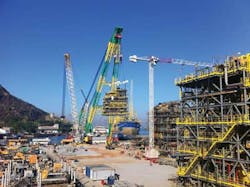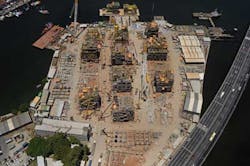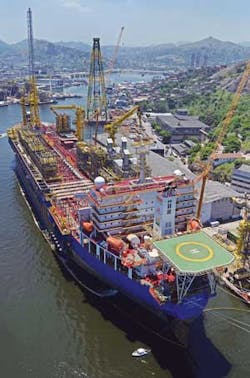Petrobras FPSOs queue up at SBM's new Brasa yard
Doug Gray
Contributing Editor
Just across the Guanabara Bay from Rio de Janeiro and the global headquarters of Petrobras, SBM's Brasa shipyard in Niteroi is completing its first project since opening in July 2012, the FPSOCidade de Ilhabela. The remarkably urban location of the country's only fully dedicated FPSO yard brings advantages as well as obstacles. But the ongoing construction of the site itself appears to be giving SBM a strong foothold in Brazil, as Petrobras pushes to keep oil production levels on target.
Developed in partnership with Brazil's Synergy group, the Brasa yard is entirely dedicated to SBM's activities, which currently include the completion of three FPSO conversions by the beginning of 2016:Cidade de Ilhabela, Cidade de Maricá, and Cidade de Saquarema. The first, a single-hull vessel destined for the presalt BM-S-9 block in the Sapinhoá field of the Santos basin, arrived in late December 2013, and docked on Jan. 12, 2014. It will eventually join the FPSO Cidade de São Paulo at Sapinhoá, which began production in January 2013. Petrobras operates the field on behalf of partners BG and Repsol.
Cidade de Ilhabela is SBM's largest FPSO to date, with a topside weighing 23,000 metric tons, around 6,000 more than its previous biggest, Cidade de Paraty. The converted VLCC will have a production capacity of 150,000 b/d of oil and storage capacity of 1.6 MMbbl. According to Production Manager Christophe Rousseau, that is about as far as these types of hulls can go. "The ship size has been staying the same but the topsides are getting higher and more compact. We are now close to the limit of capacity for these third-generation FPSOs," he said.
Short delays with the first docking aside, the schedule at Brasa has been remarkably smooth following the original build and integration in China, helped by the acquisition of the Pelicano 1 crane. "BeforeParaty, we did not have a lifting solution. Now we have our Pelicano, and can define exactly when we lift, and control the whole job more easily," says Philippe Levy, SBM Brazil director. "We are trying to support Petrobras, and they are trying to maximize their production, so we have to build to capacity."
The specific demands of working at the high pressures found in the Santos basin and the treatment of its contaminants, as well as stringent new environmental inspections, have contributed to the need for these more complex topsides. Ten modules are being built and lifted at Brasa, including the highly specialized oil processing, CO2 compression, and reinjection modules, leaving the larger, more space-demanding components like the 120-m (394-ft) flare tower to be fitted in China. Not that the modules in Brazil are small; the 2,000-metric ton CO2 injection model had to be lifted in three parts, due to the limits of the crane.
The flexibility that the Pelicano 1 crane has afforded SBM is crucial in an environment like Brasa. At 65,000 sq m (700,000 sq ft), it offers a relatively small working space, given the size of the operations. And Rousseau notes that there are some unusual variables to consider, not least the yard's neighbors. "Major lifting involves the closure of the canal to local ferries and fishing boats, and a schedule had to be agreed in advance with the (Brazilian) Navy. We start around 4 a.m., when the waters are calmest, and by mid-morning we are usually dropping the modules in place. We have a good relationship with our neighbors, but being in the city is important, because it made a good workforce easier to find."
That workforce currently stands at 3,800 and will increase to 4,000 whenMaricá and Saquarema are docked simultaneously. "We started out subcontracting around 75% of the workforce," continues Rousseau, "but that number has now inverted, so today 75% of it is permanent. It is more efficient for us to have a greater number of shifts than to start giving overtime, and with the two FPSOs coming at the end of the year we can guarantee that work going forward."
Ilhabela represents a total of 17-18 million man hours spent on the 350-m (1,148-ft) long FPSO in both Brazil and China, and will be the first project to be certified by Brazil's National Petroleum Agency (ANP) under new local content rules. Those laws demand a 65% local workforce, and have brought new partnerships with local firms like EBSE and internationals, including Flowserve and Veolia, for specific modules. Veolia's water treatment technology, for example, has been adopted specifically to help SBM fulfill those requirements. Levy says Brasa has brought the company a greater capacity for local content that is undoubtedly attractive to Petrobras.
"Petrobras is looking closely at local content and schedules, so we use the margin in (local content) to get those modules that have a production bottleneck in Brazil, elsewhere. The load banks that are essential to test the turbines, for example, are from Asia, where they have a surplus. We didn't want to waste time waiting for them in Brazil."
According to Levy, the coming projects at Brasa are not only important for SBM's position in Brazil but for the country's industry as a whole. "The definition of these third-generation FPSOs lies in their complexity. We have to eliminate H2S, inject CO2 and so on. These vessels are monsters, and their complexity is exciting," he says. "That we are doing this right here in Rio gives Petrobras the opportunity to show other managers what is possible."
The double-hullMaricá and Saquarema vessels will arrive from China two months apart at the start of 2015, stretching the capacity of the neighboring two-pier Mauá yard and pushing Brasa to a 4,000-strong team. The 10 modules built and installed for Ilhabela will be extended to 12 for next year, with six modules built and replicated for the two new vessels (CO2 compression modules will be mounted before arrival). The Cidade de Maricá and Cidade de Saquarema FPSOs are due to be completed by the end of 2015 and early 2016, respectively, and are destined for the Lula field operated by Petrobras, with partners BG and Petrogal.



